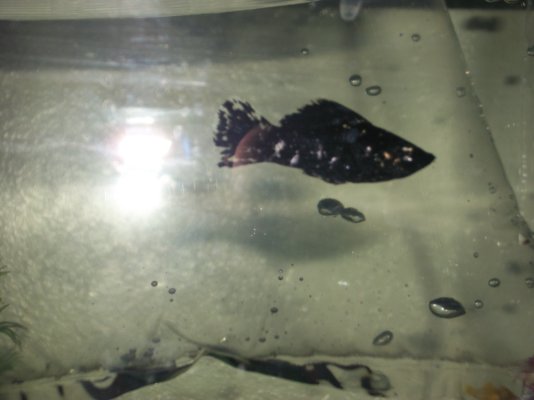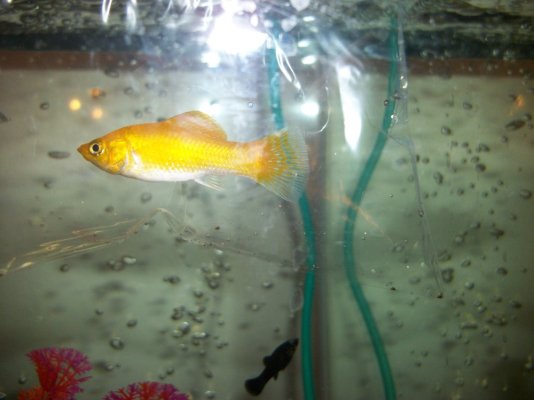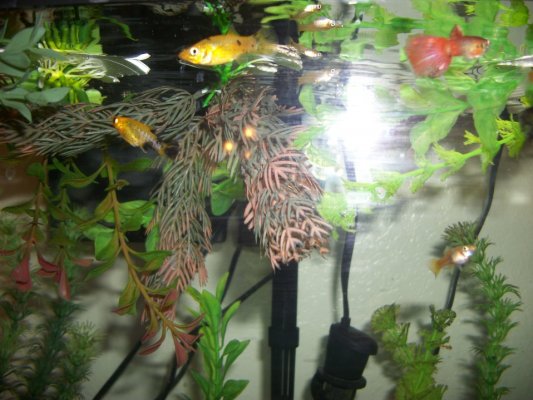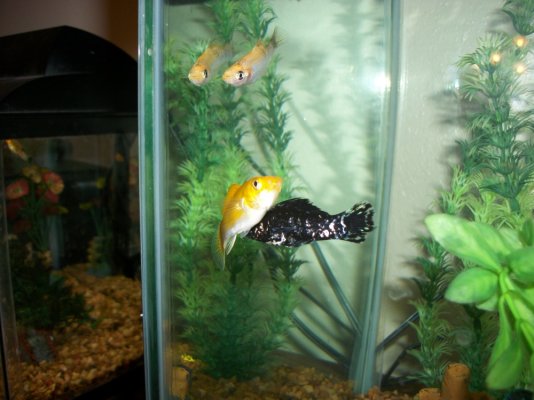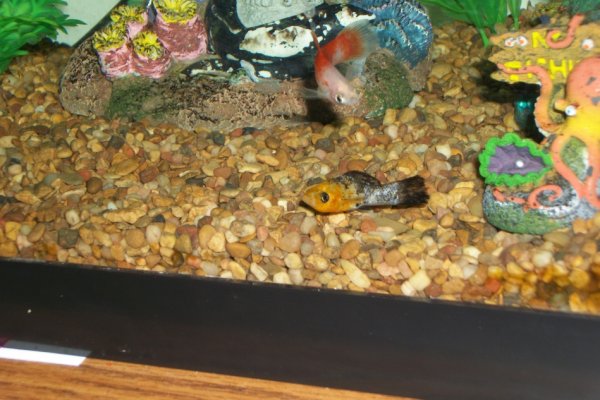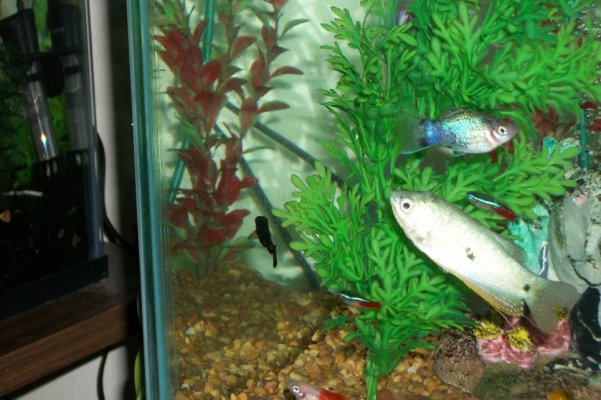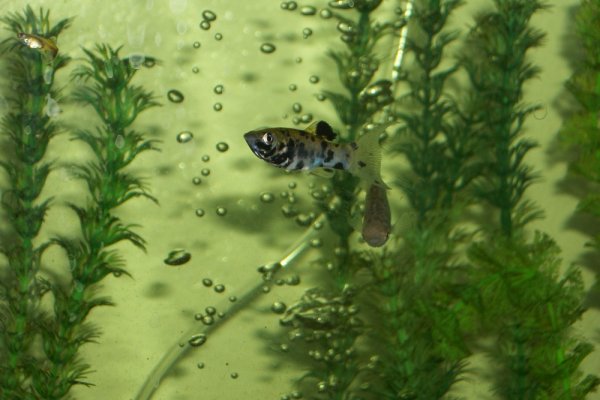Submitted by - Derail
Common Name of Fish: Poecilia latipinna
Synonyms: Poecilia sphenops, Poecilia Caucana, Poecilia velifera
Common Names: Black Molly, Gold Dust Molly, Dalmatian Molly, Lyre-tail Molly, Sailfin Molly, Short-Fin Molly, Balloon Belly Molly
Category: Live-bearer--latipinna/sphenops (most common specie names)
Genus: Poecilia
Family: Poeciliidae
Origin: Central America, around Mexico and Mexico's Yucatan Peninsula
Main Ecosystem: Estuaries, Rivers, Streams with brackish water and large amounts of vegetation
Salinity: Brackish preferred, can survive in Fresh and Marine
Temperment: Sociable, can be slightly aggressive and will set a pecking order if no other more aggressive fish is around.
Diet: Omnivore, flake food good, but will need some vegetation, esp. algae
Care: Will appreciate having floating plants to hide around (in the case of aggressive ones), and will enjoy browsing on algae. Not difficult to care for
pH: 7.5-8.5
Temperature: 72-80 F, 22-26 C
Hardness: 10-20 dh
Potential size: 4" (sometimes larger)
Water Region: Mainly the top, but will go all over the tank
Activity: Daytime
Lifespan: 3-5 years
Color: Whew...ok. Black, Blue, Gold, Green, Silver, Orange
Mouth: Upturned, no teeth
Tank Size: This really depends on how much effort you're willing to put into it, but given their activity level, I recommend a 15-20 gallon tank for minimum size, and preferably a 30 gallon tank. You will be able to keep around 3-5 molly's in a 20 gallon, and 7-9 in a 30 gallon.
Stocking: When stocking these gorgeous fish, you will want to either follow a ratio or keep all fish of the same sex, but remember that males may not agree with each other. If following the ratio, 1 male to 2-3 females is best, as the Molly's are prolific breeders, just like Guppies. If kept in even ratios, say 4 males and 4 females, the male fish will quarrel amongst each other and also harass the females for breeding to the point of illness and even death. Also, if keeping more than one male, keep odd numbers so there isn't a single dominant male, pair of dominant, etc. You may add these fish depending on your cycling method (be it Fish-In cycle or fishless, or even silent), but prepare to deal with the establishment of a pecking order. By the way, if you do not know, a pecking order is basically which fish eat first. To avoid this and reduce the established territorial issues, you can remove the fish and reorganize the tank so all have an equal chance. This is more important for really territorial fish like cichlids, but I digress.
Sexing: Males are typically smaller than females (unlike Guppies, "colorfulness" doesn't work as both sexes are colorful!) Also, Male Molly's have a tube-like anal fin called the Gonopodium, and females have a "fanned" anal fin. First picture I've added is male, (dalmatian sail-fin), second is female (gold-dust, short finned).
Acclimation: Drip-method is not necessary, as these fish aren't super fragile. Float the bag containing the fish in the water for about 15 min to allow temps to equalize. Then open the bag and add a few scoops of water to the bag. Repeat this after about 10 minutes for 45 min to an hour and then net the fish and add them to avoid introducing any bacteria to the tank.
Breeding: Absolutely simple. In fact, stopping these fish from breeding would be a bigger accomplishment . Keep your parameters around their range, house a male with a few females and it will occur naturally. The male will turn his Gonopodium forward and press it to the female, which allows the transfer of sperm, which she will utilize to fertilize her eggs. Also, note that a female will remain fertile for several months after successfully breeding, even if removed from males since they can store the sperm for future broods. The fry will be born live, hence these fish being called live-bearers, and these fish may drop as many as 10-60 fry in a single brood, with larger numbers being born as the mother has more experience. To assist in encouraging breeding, feed the fish a varied diet of flakes, vegetables (such as unseasoned peas with the shell removed), and live foods or freeze-dried foods (bloodworms are great for this). You'll know when she's pregnant as she will begin to get larger and her belly will ultimately start to take on a "box" or "square" appearance. In the case of lighter colored females, her gravid spot (dark spot by the vent) will grow in size. Gestation for Molly's is about 30 days, give or take a few days depending on diet, genetics, etc.
. Keep your parameters around their range, house a male with a few females and it will occur naturally. The male will turn his Gonopodium forward and press it to the female, which allows the transfer of sperm, which she will utilize to fertilize her eggs. Also, note that a female will remain fertile for several months after successfully breeding, even if removed from males since they can store the sperm for future broods. The fry will be born live, hence these fish being called live-bearers, and these fish may drop as many as 10-60 fry in a single brood, with larger numbers being born as the mother has more experience. To assist in encouraging breeding, feed the fish a varied diet of flakes, vegetables (such as unseasoned peas with the shell removed), and live foods or freeze-dried foods (bloodworms are great for this). You'll know when she's pregnant as she will begin to get larger and her belly will ultimately start to take on a "box" or "square" appearance. In the case of lighter colored females, her gravid spot (dark spot by the vent) will grow in size. Gestation for Molly's is about 30 days, give or take a few days depending on diet, genetics, etc.
Rearing the Fry: When the mother is ready to drop her fry, move her to a breeder net to allow the fry to remain safe from the other fish. Molly fish have no maternal instincts, so they will eat their young. In some cases, other fish may even sit right behind them and eat fry as they are born . It is also a good idea to remove the mother to a separate 5-10 gallon tank with plenty of plants and gentle filtration. When the birthing process is complete (which may take a few hours), gently move the mother back to the main tank so she doesn't consume her babies. Babies may be fed liquid fry food, powdered flakes or even powdered blood-worms. When the fry are large enough, they may be moved to the main tank, or let out of the breeder net/trap. Also, if you would prefer to let natural selection take its course, you can let the mother give birth in the main tank, but don't count on all the adult fish to cull the brood and never have babies grow up!
. It is also a good idea to remove the mother to a separate 5-10 gallon tank with plenty of plants and gentle filtration. When the birthing process is complete (which may take a few hours), gently move the mother back to the main tank so she doesn't consume her babies. Babies may be fed liquid fry food, powdered flakes or even powdered blood-worms. When the fry are large enough, they may be moved to the main tank, or let out of the breeder net/trap. Also, if you would prefer to let natural selection take its course, you can let the mother give birth in the main tank, but don't count on all the adult fish to cull the brood and never have babies grow up!
Fry Tank: As mentioned before, the rearing tank should have plenty of plants and gentle filtration. Many people recommend a small internal filter. Floating plants will be highly useful as the fry will naturally hide in these after being born to avoid being eaten. Once the fry have reached an appropriate, they may be moved back to the main tank (whether it be community or specie tank). The appropriate size is a judgement call, typically if the fry are too large to fit in the mouths of the adults, then they will be OK.
Comments: There are plenty of sources that indicate these fish aren't good to be kept with any other fish or as a community fish as they have a somewhat large bioload and can be aggressive to other fish. I've kept Molly's for several years now, recently got into really breeding them and have had no problem keeping them with other live-bearers, such as Guppy's. While these fish can be kept in completely fresh-water aquariums, it is best to have at least 1 tablespoon of aquarium (NOT table) salt per 10 gallons of water (or w/e the measurements on your salt indicate) for optimum health. Being from brackish water, these fish can be kept in this, or if acclimated properly, can be kept in marine aquariums as well, and are fantastic algae eaters, but you can't count on them to remove all the algae! I did have a good two month spat with dealing with a single molly being rather aggressive to the others, since she thought she was the alpha in the aquarium. Adding a male and rearranging everything really helped with it. On a note, as I have mentioned Ballon Belly Molly's. Many people love these fish and they certainly are good a getting attention. Personally, I'm not a huge fan of breeding any fish for a deformity that gives it a disadvantage as far as nature is concerned.
I did have a good two month spat with dealing with a single molly being rather aggressive to the others, since she thought she was the alpha in the aquarium. Adding a male and rearranging everything really helped with it. On a note, as I have mentioned Ballon Belly Molly's. Many people love these fish and they certainly are good a getting attention. Personally, I'm not a huge fan of breeding any fish for a deformity that gives it a disadvantage as far as nature is concerned.
Send me a message if you have any questions or concerns about keeping Molly's, and I'll do my best to get back to ya asap for help
Sources: Kept molly's for years, over 40+ hours of reading up on them online. Some books too.
The Essential Freshwater Aquarium by Betsy Sikora Siino (published by Howell Book House)
Aquarium Fish by Don Harper (published by Collins discover)
Pictures of my own fish . Thanks for this awesome site and the opportunity to share this information! Picture Comments: Pic 1: Dalmation Molly Male, note the lack of a fanned fin on the underside. Pic 2: Female Gold Dust Molly: Note her fanned anal fin. Pic 3: Molly's and Guppy's chilling together, note that these are young fish. Pic 4: A group of two female Molly's and a Male Molly.
. Thanks for this awesome site and the opportunity to share this information! Picture Comments: Pic 1: Dalmation Molly Male, note the lack of a fanned fin on the underside. Pic 2: Female Gold Dust Molly: Note her fanned anal fin. Pic 3: Molly's and Guppy's chilling together, note that these are young fish. Pic 4: A group of two female Molly's and a Male Molly.
Common Name of Fish: Poecilia latipinna
Synonyms: Poecilia sphenops, Poecilia Caucana, Poecilia velifera
Common Names: Black Molly, Gold Dust Molly, Dalmatian Molly, Lyre-tail Molly, Sailfin Molly, Short-Fin Molly, Balloon Belly Molly
Category: Live-bearer--latipinna/sphenops (most common specie names)
Genus: Poecilia
Family: Poeciliidae
Origin: Central America, around Mexico and Mexico's Yucatan Peninsula
Main Ecosystem: Estuaries, Rivers, Streams with brackish water and large amounts of vegetation
Salinity: Brackish preferred, can survive in Fresh and Marine
Temperment: Sociable, can be slightly aggressive and will set a pecking order if no other more aggressive fish is around.
Diet: Omnivore, flake food good, but will need some vegetation, esp. algae
Care: Will appreciate having floating plants to hide around (in the case of aggressive ones), and will enjoy browsing on algae. Not difficult to care for
pH: 7.5-8.5
Temperature: 72-80 F, 22-26 C
Hardness: 10-20 dh
Potential size: 4" (sometimes larger)
Water Region: Mainly the top, but will go all over the tank
Activity: Daytime
Lifespan: 3-5 years
Color: Whew...ok. Black, Blue, Gold, Green, Silver, Orange
Mouth: Upturned, no teeth
Tank Size: This really depends on how much effort you're willing to put into it, but given their activity level, I recommend a 15-20 gallon tank for minimum size, and preferably a 30 gallon tank. You will be able to keep around 3-5 molly's in a 20 gallon, and 7-9 in a 30 gallon.
Stocking: When stocking these gorgeous fish, you will want to either follow a ratio or keep all fish of the same sex, but remember that males may not agree with each other. If following the ratio, 1 male to 2-3 females is best, as the Molly's are prolific breeders, just like Guppies. If kept in even ratios, say 4 males and 4 females, the male fish will quarrel amongst each other and also harass the females for breeding to the point of illness and even death. Also, if keeping more than one male, keep odd numbers so there isn't a single dominant male, pair of dominant, etc. You may add these fish depending on your cycling method (be it Fish-In cycle or fishless, or even silent), but prepare to deal with the establishment of a pecking order. By the way, if you do not know, a pecking order is basically which fish eat first. To avoid this and reduce the established territorial issues, you can remove the fish and reorganize the tank so all have an equal chance. This is more important for really territorial fish like cichlids, but I digress.
Sexing: Males are typically smaller than females (unlike Guppies, "colorfulness" doesn't work as both sexes are colorful!) Also, Male Molly's have a tube-like anal fin called the Gonopodium, and females have a "fanned" anal fin. First picture I've added is male, (dalmatian sail-fin), second is female (gold-dust, short finned).
Acclimation: Drip-method is not necessary, as these fish aren't super fragile. Float the bag containing the fish in the water for about 15 min to allow temps to equalize. Then open the bag and add a few scoops of water to the bag. Repeat this after about 10 minutes for 45 min to an hour and then net the fish and add them to avoid introducing any bacteria to the tank.
Breeding: Absolutely simple. In fact, stopping these fish from breeding would be a bigger accomplishment
Rearing the Fry: When the mother is ready to drop her fry, move her to a breeder net to allow the fry to remain safe from the other fish. Molly fish have no maternal instincts, so they will eat their young. In some cases, other fish may even sit right behind them and eat fry as they are born
Fry Tank: As mentioned before, the rearing tank should have plenty of plants and gentle filtration. Many people recommend a small internal filter. Floating plants will be highly useful as the fry will naturally hide in these after being born to avoid being eaten. Once the fry have reached an appropriate, they may be moved back to the main tank (whether it be community or specie tank). The appropriate size is a judgement call, typically if the fry are too large to fit in the mouths of the adults, then they will be OK.
Comments: There are plenty of sources that indicate these fish aren't good to be kept with any other fish or as a community fish as they have a somewhat large bioload and can be aggressive to other fish. I've kept Molly's for several years now, recently got into really breeding them and have had no problem keeping them with other live-bearers, such as Guppy's. While these fish can be kept in completely fresh-water aquariums, it is best to have at least 1 tablespoon of aquarium (NOT table) salt per 10 gallons of water (or w/e the measurements on your salt indicate) for optimum health. Being from brackish water, these fish can be kept in this, or if acclimated properly, can be kept in marine aquariums as well, and are fantastic algae eaters, but you can't count on them to remove all the algae!
Send me a message if you have any questions or concerns about keeping Molly's, and I'll do my best to get back to ya asap for help
Sources: Kept molly's for years, over 40+ hours of reading up on them online. Some books too.
The Essential Freshwater Aquarium by Betsy Sikora Siino (published by Howell Book House)
Aquarium Fish by Don Harper (published by Collins discover)
Pictures of my own fish
Attachments
Last edited:

